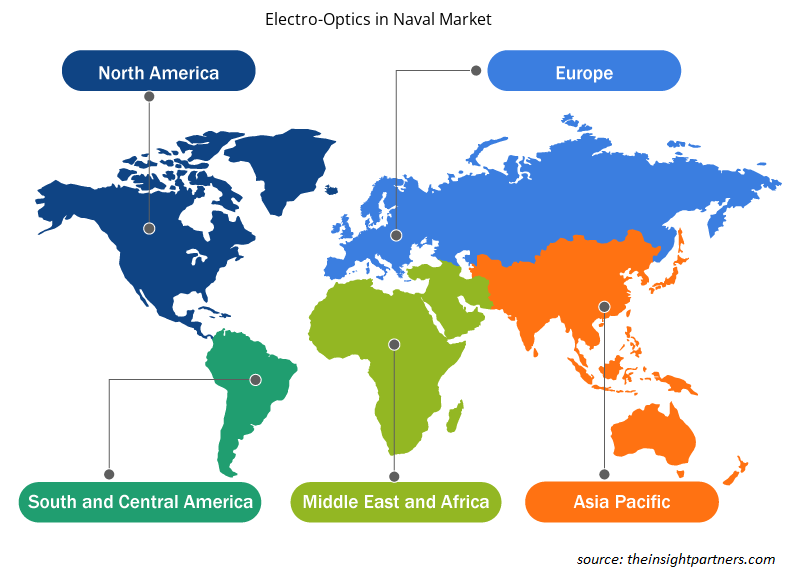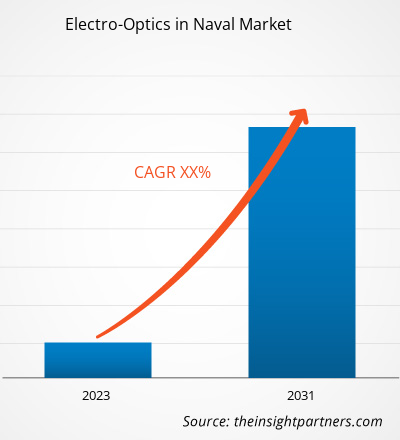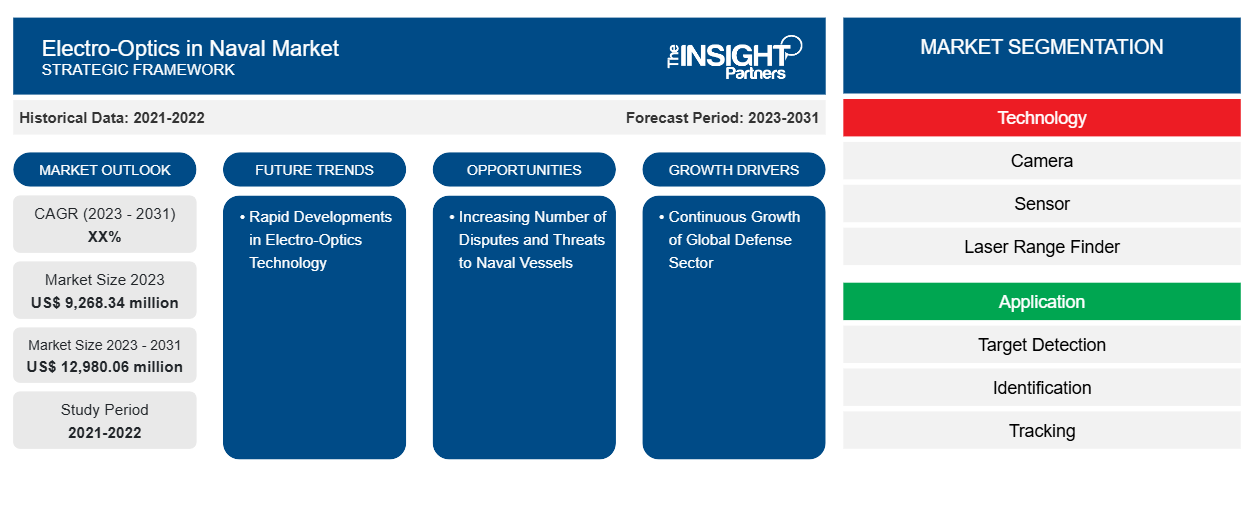Se estima que el tamaño del mercado de la electroóptica en el sector naval alcanzará los 12.980,06 millones de dólares en 2031, frente a los 9.268,34 millones de dólares en 2023. La electroóptica ha permitido ejecutar misiones con éxito, ya que posee características y capacidades únicas que se adaptan mejor a la orientación, la vigilancia y el conocimiento de la situación en el sector naval. Las empresas del mercado están diseñando una solución electroóptica para proporcionar una operación y vigilancia superiores en un paquete liviano y de menor costo que respalde de manera efectiva los requisitos de múltiples misiones para la detección, identificación, vigilancia y evaluación de objetivos de superficies de espectro completo.
Análisis del mercado de la electroóptica en la marina
Con la expansión naval, se produce un aumento y las preocupaciones por la seguridad nacional siguen aumentando en la actividad marítima comercial en lo que respecta a la construcción naval y la inversión en infraestructura portuaria. Además, las fuertes inversiones en la modernización y actualización de la tecnología electroóptica, el aumento de la necesidad de capacidades de ISR y la adopción de vehículos de superficie no tripulados (USV) se encuentran entre los principales factores que impulsan el crecimiento de la electroóptica en el mercado naval. Por ejemplo, en septiembre de 2022, L3Harris Technologies Inc recibió un contrato de la Marina de los EE. UU. por valor de 8,9 millones de dólares para suministrar sensores electroópticos para aplicaciones de control de fuego en los cañones de cubierta de los buques de guerra. Sin embargo, el estancamiento del ciclo de vida de los sistemas electroópticos navales que reduce la demanda de productos para instalaciones de modernización es uno de los principales factores que limitan el crecimiento del mercado. Por el contrario, se prevé que el aumento de la conciencia situacional basada en el mar, el aumento de la necesidad de mejores sistemas de sensores que sean altamente confiables y precisos para la patrulla marítima y los rápidos desarrollos e inversiones en I+D creen oportunidades de crecimiento lucrativas para el mercado en los próximos años.
Panorama del mercado de la electroóptica en la marina
Los sistemas electroópticos navales consisten en módulos de imágenes de múltiples sensores que atienden las necesidades de vigilancia, monitoreo, control de fuego y búsqueda y seguimiento panorámicos. Además, la electroóptica permite la detección de todas las amenazas aéreas y de superficie, tanto simétricas como asimétricas, independientemente de la hora del día y las condiciones climáticas. Además, para operaciones de seguridad en alta mar y costeras, los sistemas electroópticos proporcionan sistemas de vigilancia, control de fuego y defensa aérea para varios buques de superficie, incluidos portaaviones, fragatas , corbetas, patrulleras oceánicas y costeras y naves de alta velocidad. Además, los sensores electroópticos están operativos en varias aplicaciones aéreas, terrestres y navales, proporcionando datos de posición y orientación necesarios para la operación y la adquisición de objetivos. Además, los sensores proporcionan alerta temprana, monitoreo de actividad anormal, gestión de incidentes y capacidades integrales de observación y reacción.
Personalice este informe según sus necesidades
Obtendrá personalización en cualquier informe, sin cargo, incluidas partes de este informe o análisis a nivel de país, paquete de datos de Excel, así como también grandes ofertas y descuentos para empresas emergentes y universidades.
-
Obtenga las principales tendencias clave del mercado de este informe.Esta muestra GRATUITA incluirá análisis de datos, desde tendencias del mercado hasta estimaciones y pronósticos.
Impulsores y oportunidades del mercado de la electroóptica en la industria naval
Crecimiento continuo del sector de defensa global
El cambio en el sistema de guerra moderno ha estado impulsando a los gobiernos de todo el mundo a asignar grandes fondos a las respectivas fuerzas militares. La asignación del presupuesto militar permite a las fuerzas militares adquirir tecnologías y equipos avanzados de fabricantes nacionales o internacionales. Las prácticas de modernización de soldados y vehículos militares también están en aumento en numerosos países. Para fortalecer las fuerzas militares con tecnologías avanzadas, armamentos , artillería, aviones de combate, buques de guerra y vehículos blindados, las fuerzas de defensa de todo el mundo están invirtiendo cantidades sustanciales en los productos antes mencionados. La continua necesidad de nuevas tecnologías para operaciones de combate y no combate por parte de las fuerzas de defensa está impulsando el gasto en defensa en todo el mundo.
Aumenta el número de disputas y amenazas a los buques de guerra
Debido al aumento de las disputas marítimas y las amenazas a las fuerzas de los buques de guerra, los países están invirtiendo en sistemas electroópticos avanzados para aplicaciones marítimas como la detección de amenazas, la vigilancia y la identificación de objetivos. Además, el creciente número de conflictos territoriales y cuestiones fronterizas aumenta el riesgo para los activos marítimos, lo que lleva a un énfasis cada vez mayor en la vigilancia, la detección de amenazas y la identificación de objetivos en el mar. Además, las fuerzas navales se centran cada vez más en incorporar e integrar sistemas de sensores sofisticados y avanzados en sus buques de guerra. Además, se ha vuelto importante que los buques de guerra obtengan imágenes en movimiento de sensores electroópticos que proporcionen ojos de día y de noche y de largo alcance en el objetivo. Además, mejora la capacidad del buque para identificar objetivos, apoya el compromiso de armas a través de soluciones de seguimiento automático y control de fuego a través de la línea de visión, y realiza una evaluación de amenazas. Además, las tensiones constantes entre países como China-India, India-Pakistán, China-Taiwán, Rusia-China, EE. UU.-Rusia; Además, los conflictos en curso entre países como Rusia-Ucrania, India-China y China-Taiwán son algunos de los principales factores que generan la demanda de sistemas electroópticos en las fuerzas de defensa de estos países. Dicha tensión entre los países ha impulsado la necesidad de operaciones en buques de guerra, lo que a su vez impulsa la demanda de cámaras electroópticas, sensores y telémetros láser en diferentes regiones.
Análisis de segmentación del informe del mercado de electroóptica en la marina
Los segmentos clave que contribuyeron a la derivación de la electroóptica en el análisis del mercado naval son la tecnología, la aplicación y el uso final.
- Según la tecnología, el mercado mundial de la electroóptica en el sector naval se segmenta en cámaras, sensores y telémetros láser. El segmento de las cámaras tuvo una mayor participación de mercado en 2023.
- Según la aplicación, el mercado mundial de sistemas electroópticos en el sector naval se segmenta en detección, identificación y seguimiento de objetivos, vigilancia, control de tiro y otros. Además, la creciente inclinación hacia la vigilancia está acelerando el crecimiento del segmento a la tasa de CAGR más alta.
- Según el uso final, el mercado mundial de sistemas electroópticos para uso naval se segmenta en defensa y comercial. El segmento de defensa tuvo una mayor participación de mercado en 2023.
Análisis de la cuota de mercado de la electroóptica en la marina por geografía
El mercado mundial de electroóptica en la marina está segmentado en cinco regiones principales: América del Norte, Europa, APAC, Oriente Medio y África (MEA) y América del Sur (SAM). América del Norte tuvo la mayor participación del mercado mundial de electroóptica en la marina en 2021. A lo largo de los años, los países de América del Norte han experimentado un aumento en su gasto militar para mejorar sus capacidades de tropas terrestres, marítimas y aéreas, lo que está llevando a la adopción de tecnologías avanzadas entre las fuerzas militares. En febrero de 2022, la Marina de los EE. UU. adjudicó un contrato a Teledyne FLIR, una subsidiaria de Teledyne Technologies, para mantener y suministrar sistemas de imágenes multisensoriales BRITE Star II para el programa H-1 de la Marina de los EE. UU. Además, hay una mayor adopción de tecnologías avanzadas de cámaras y sensores en los buques de guerra para aplicaciones como detección de objetivos, seguimiento, vigilancia y control de fuego. Todos estos factores están impulsando colectivamente el crecimiento del mercado.
Perspectivas regionales sobre electroóptica en el mercado naval
Los analistas de Insight Partners explicaron en detalle las tendencias y los factores regionales que influyen en el mercado de la electroóptica en la industria naval durante el período de pronóstico. Esta sección también analiza los segmentos y la geografía del mercado de la electroóptica en la industria naval en América del Norte, Europa, Asia Pacífico, Oriente Medio y África, y América del Sur y Central.

- Obtenga los datos regionales específicos para el mercado electroóptico naval
Alcance del informe sobre el mercado de la electroóptica en la marina
| Atributo del informe | Detalles |
|---|---|
| Tamaño del mercado en 2023 | US$ 9.268,34 millones |
| Tamaño del mercado en 2031 | US$ 12.980,06 millones |
| CAGR global (2023 - 2031) | XX% |
| Datos históricos | 2021-2022 |
| Período de pronóstico | 2023-2031 |
| Segmentos cubiertos |
Por tecnología
|
| Regiones y países cubiertos |
América del norte
|
| Líderes del mercado y perfiles de empresas clave |
|
Densidad de actores del mercado: comprensión de su impacto en la dinámica empresarial
El mercado de la electroóptica en el sector naval está creciendo rápidamente, impulsado por la creciente demanda de los usuarios finales debido a factores como la evolución de las preferencias de los consumidores, los avances tecnológicos y una mayor conciencia de los beneficios del producto. A medida que aumenta la demanda, las empresas amplían sus ofertas, innovan para satisfacer las necesidades de los consumidores y aprovechan las tendencias emergentes, lo que impulsa aún más el crecimiento del mercado.
La densidad de actores del mercado se refiere a la distribución de las empresas o firmas que operan dentro de un mercado o industria en particular. Indica cuántos competidores (actores del mercado) están presentes en un espacio de mercado determinado en relación con su tamaño o valor total de mercado.
Las principales empresas que operan en el mercado de electroóptica naval son:
- Safran SA
- Tecnologías L3Harris, Inc.
- Ultra Marítimo
- Imágenes de Tonbo
- Aselsan AS
- Sistemas Elbit Ltd.
Descargo de responsabilidad : Las empresas enumeradas anteriormente no están clasificadas en ningún orden particular.

- Obtenga una descripción general de los principales actores clave del mercado de electroóptica naval
Noticias y desarrollos recientes sobre electroóptica en el mercado naval
El mercado de la electroóptica en la industria naval se evalúa mediante la recopilación de datos cualitativos y cuantitativos a partir de investigaciones primarias y secundarias, que incluyen publicaciones corporativas importantes, datos de asociaciones y bases de datos. A continuación, se incluye una lista de los avances en el mercado en cuanto a innovaciones, expansión comercial y estrategias:
- En noviembre de 2022, el Centro de Guerra Submarina Naval (NUWC) anunció un contrato de 173,2 millones de dólares con SAAB para construir, probar y entregar drones que puedan evaluar el comportamiento y la firma de los sensores del enemigo. (Fuente: Centro de Guerra Submarina Naval, comunicado de prensa)
- En junio de 2022, un equipo dirigido por L3Harris Technologies (NYSE:LHX) fue seleccionado para proporcionar el sistema panorámico electroóptico/infrarrojo (SPEIR) a bordo a la Marina de los EE. UU. que brindará una mejor protección a la flota. El contrato inicial de $205 millones tiene un valor potencial de $593 millones si se ejercen todas las opciones hasta marzo de 2031. (Fuente: L3Harris Technologies, comunicado de prensa)
Informe sobre el mercado de la electroóptica en la marina: cobertura y resultados
El informe “Tamaño y pronóstico del mercado de electroóptica en la marina (2021-2031)” proporciona un análisis detallado del mercado que abarca las siguientes áreas:
- Tamaño del mercado de electroóptica en el sector naval y pronóstico a nivel global, regional y nacional para todos los segmentos clave del mercado cubiertos por el alcance.
- Dinámica del mercado, como impulsores, restricciones y oportunidades clave
- Tendencias de la electroóptica en el mercado naval
- Análisis detallado de las cinco fuerzas de Porter y PEST y FODA
- Análisis del mercado de la electroóptica en el sector naval que abarca las tendencias clave del mercado, el marco global y regional, los principales actores, las regulaciones y los desarrollos recientes del mercado
- Panorama del mercado de la electroóptica en la industria naval y análisis de la competencia que abarca la concentración del mercado, el análisis de mapas de calor, los actores destacados y los desarrollos recientes.
- Perfiles detallados de empresas
- Análisis histórico (2 años), año base, pronóstico (7 años) con CAGR
- Análisis PEST y FODA
- Tamaño del mercado, valor/volumen: global, regional y nacional
- Industria y panorama competitivo
- Conjunto de datos de Excel
Informes recientes
Informes relacionados
Testimonios
Razón para comprar
- Toma de decisiones informada
- Comprensión de la dinámica del mercado
- Análisis competitivo
- Información sobre clientes
- Pronósticos del mercado
- Mitigación de riesgos
- Planificación estratégica
- Justificación de la inversión
- Identificación de mercados emergentes
- Mejora de las estrategias de marketing
- Impulso de la eficiencia operativa
- Alineación con las tendencias regulatorias























 Obtenga una muestra gratuita para - Electroóptica en el mercado naval
Obtenga una muestra gratuita para - Electroóptica en el mercado naval